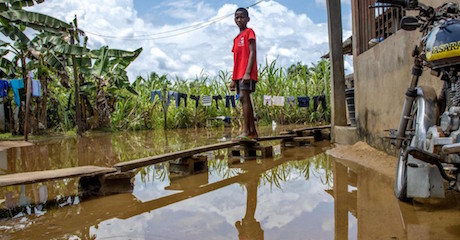The worst flooding to hit Nigeria in a decade has killed more than 600 people and displaced over 1.3 million in 34 out of the country’s 36 states since September.
High rainfall and overflow from rivers have destroyed or partly damaged more than 200,000 houses. Rising flood levels have collapsed infrastructure including public health facilities, water systems and sanitation facilities, increasing the risk of waterborne diseases like cholera, diarrhea and malaria.
Children living in makeshift displacement sites lack basic water, sanitation and hygiene (WASH) facilities. They are also exposed to increased protection risks including separation from their famllies and gender-based violence.
More than 2.5 million people in Nigeria are in need of humanitarian assistance and are at increased risk of waterborne diseases, drowning and malnutrition due to the most severe flooding in the past decade.
See full press release —-https://t.co/IJsX8LvGyr— UNICEF Nigeria (@UNICEF_Nigeria) October 21, 2022
“Children and adolescents in flood-afftected areas are in an extremely vulnerable situation,” said Cristian Muduate, UNICEF Representative in Nigeria. “They are particularly at risk of waterborne diseases and emotional and psychological distress. UNICEF is working closely with the government and other partners to provide lifesaving assistance to those who are most in need.”
The floods are the latest hardship in what is already a precarious humanitarian situation in Nigeria. Immediate priority needs for children include health and WASH, along with shelter and food.
Akpoebi Germany, left, stands on a narrow plank bridge outside his home, with his children, from left: Peretimifa, Samuel and Joy in Sagbama, Bayelsa State, Nigeria. © UNICEF/UN0722934/Esiebo
According to UNICEF’s Children’s Climate Risk Index, released in 2021, Nigeria is considered to be at “extremely high risk” of the impacts of climate change, ranking second — tied with Chad, after the Central African Republic — out of 163 countries.
Globally, approximately 1 billion children are growing up in “extremely high risk” countries. They face a deadly combination: exposure to multiple climate and environmental shocks on top of existing vulnerabilities.
Floodwaters surround Adagbabiri Primary Health Center in Sagabama, Bayelsa State, Nigeria. © UNICEF/UN0722936/Esiebo
To date, UNICEF has supported flood response in three Nigerian states — Jigawa, Niger and Kaduna — through a mix of emergency cash transfers, distribution of cholera prevention kits and learning materials, government-led mobile health teams and temporary learning centers.
With additional support, UNICEF can scale up its response in other states, including providing lifesaving medicines and medical equipment and water chlorination and sanitation supplies, and supporting sexual and gender-based violence prevention and response.
Help UNICEF reach vulnerable children survive the impacts of climate change.Your contribution can make a difference.
Top photo: Peretimfa, 11, stands on a makeshift wooden walkway over floodwaters outside his home in Sagbama, Bayelsa State, Nigeria. Flooding in Bayelsa has forced schools to close, leaving children like Peretimfa stuck at home, missing their classmates and eager to get back to learning. © UNICEF/UN0722938/Esiebo
